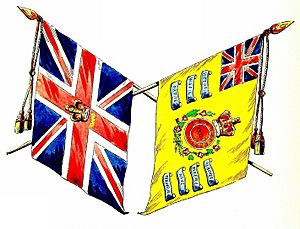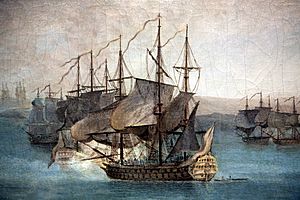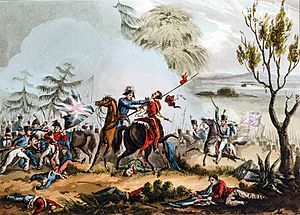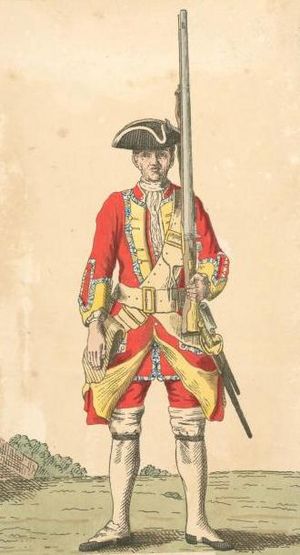34th (Cumberland) Regiment of Foot facts for kids
Quick facts for kids 34th (Cumberland) Regiment of Foot |
|
|---|---|

Colours of the 34th (Cumberland) Regiment of Foot
|
|
| Active | 1702–1881 |
| Country |
|
| Branch | |
| Garrison/HQ | Carlisle Castle |
| Nickname(s) | Cumberland Gentlemen |
| Engagements | War of the Spanish Succession Seven Years' War American Revolutionary War Napoleonic Wars Upper Canada Rebellion Crimean War Indian Rebellion |
The 34th Regiment of Foot was a special group of soldiers in the British Army. They were like foot soldiers, or infantry, and were first formed in 1702. Later, in 1881, they joined with another group called the 55th (Westmorland) Regiment of Foot. Together, they became a new group called the Border Regiment. This happened because of big changes in the army called the Childers Reforms.
Contents
History of the 34th Regiment
Early Adventures
The 34th Regiment started in 1702 in East Anglia, England. It was first called 'Lord Lucas's Regiment of Foot'. Their first big job was to fight in the War of Spanish Succession. This was a war where many countries in Europe fought over who would be the next king of Spain.
The soldiers went to Spain in 1702. They helped in a big fight called the siege of Barcelona in 1705. A siege is when an army surrounds a city or fort to try and take it over. After this, they went to Tortosa before coming back to England in 1707.
Later, they went to France and fought in more sieges, like the siege of Lille in 1708. They also fought at Douai and Bouchain. After these battles, they returned to England and were temporarily disbanded in 1713. But they were soon reformed in 1715.
In 1719, they sailed again and helped capture Vigo in Spain during the War of the Quadruple Alliance. This was another war where European countries fought over power.
The regiment went to Flanders (part of modern-day Belgium) in 1744. They fought in the Battle of Fontenoy in 1745 during the War of the Austrian Succession. This war was about who would rule Austria.
In 1745, they were called back to England to help stop a rebellion called the Jacobite rising of 1745. They fought bravely at the Battle of Culloden in 1746. In 1751, the King decided that regiments should be known by a number, not by their colonel's name. So, they officially became the 34th Regiment of Foot.
Seven Years' War Battles

In 1755, the regiment was sent to Menorca, an island in the Mediterranean Sea. A large group of French soldiers surrounded them. The British soldiers, including the 34th, had to retreat to Fort St Phillip. They defended the fort for two months. Even when their own navy seemed to leave them, they kept fighting. Eventually, they had to give up and went to Gibraltar.
A second group of soldiers was formed in 1757. They acted as marines, who are soldiers trained to fight on land and sea. The regiment then took part in raids on French towns like St Malo and Cherbourg in 1758. They also fought in the Battle of Saint Cast.
The regiment later joined a British mission to Cuba in 1762. They helped capture Fort Morro and then the city of Havana. The next year, they went to Florida, which was given to Britain by Spain. They finally returned to England in 1768.
Fighting in America
In 1776, the regiment was sent to Canada to fight in the American Revolutionary War. They had many small fights and pushed American forces out of Fort Ticonderoga in 1777. Some soldiers from the regiment also tried to take Fort Stanwix, but they were not successful.
A special group of skilled shooters, called the Company of Select Marksmen, was part of the 34th Regiment. They fought as skirmishers, meaning they were sent ahead to fight in small groups. This happened during the Saratoga campaign in 1777. Some of their officers and soldiers were captured by the Americans.
In 1780, a ship called HMS Ontario sank in a big storm on Lake Ontario. About 80 people died, including 34 soldiers, an officer, four women, and five children from the regiment. The ship was lost for a long time until it was found in 2008.
In 1782, the regiment was given a special county name and became the 34th (Cumberland) Regiment of Foot. They returned to England in 1786.
Napoleonic Wars and Beyond

In 1795, the regiment went to the West Indies. They were based in Saint Lucia and protected the island from French forces. They also helped stop a rebellion in Saint Vincent. They came back to England in 1797.
Later, they were sent to the Cape of Good Hope in 1800 and then to India in 1802. They stayed in India for 19 years, fighting against the Maratha Empire.
A second group of soldiers was formed in 1804. This group went to Portugal in 1809 to fight in the Peninsular War. This was part of the bigger Napoleonic Wars against Napoleon's French army.
The second group fought in many important battles. They helped in the siege of Badajoz in 1811. At the Battle of Albuera in May 1811, their flag bearer was shot, but the regiment's flags were bravely saved. They also captured drums and a special stick from a French regiment at the Battle of Arroyo dos Molinos in 1811.
They continued to fight in Spain, including the siege of Ciudad Rodrigo in 1812 and the Battle of Vitoria in 1813. They then chased the French army into France, fighting in battles like the Battle of the Pyrenees and the Battle of Toulouse in 1814. After these victories, they went to Ireland in 1814.
Victorian Era Service
In 1829, the regiment was sent to Canada. Some of their soldiers fought American groups called Hunters' Lodges at the Battle of Windsor in 1838. This was during a time of unrest called the Upper Canada Rebellion. The regiment returned to England in 1841.
Back home, they helped stop protests by a group called the Chartists in 1842. Their next big battle was the siege of Sevastopol in 1854, during the Crimean War. This war was fought against Russia.
They also fought in India during the Indian Rebellion. They were involved in the siege of Cawnpore in 1857 and the siege of Lucknow later that year.
In the 1870s, the British Army made more changes. The 34th Regiment was linked with the 55th (Westmorland) Regiment of Foot. They shared a training center at Carlisle Castle. Finally, on July 1, 1881, the 34th Regiment officially joined with the 55th Regiment to form the new Border Regiment.
Battle Honours
Battle honours are special awards given to military units for their bravery and success in battles. Here are some of the honours won by the 34th Regiment:
- Peninsular War: Albuhera, Arroyo dos Molinos, Vittoria, Pyrenees, Nivelle, Nive, Orthes, Peninsula
- Crimean War: Sevastopol
- Indian Mutiny: Lucknow
- West Indies: Havannah (This one was given to the Border Regiment later, in 1909)
Victoria Crosses
The Victoria Cross is the highest award for bravery in the British military. It is given for extreme courage in the face of the enemy. Here are the soldiers from the 34th Regiment who earned this amazing honour:
- Private William Coffey, during the Crimean War (March 29, 1855)
- Private George Richardson, during the Indian Mutiny (April 27, 1859)
- Private John Joseph Sims, during the Crimean War (June 18, 1855)


